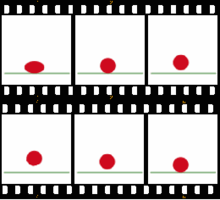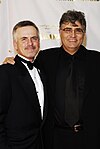
Back بوابة:رسوم متحركة Arabic دەروازە:ئەنیمەیشن CKB Portal:Animation German درگاه:پویانمایی Persian Portail:Animation French Portale:Animazione Italian Portal:アニメ Japanese 포털:애니메이션 Korean Portal:Animação Portuguese Портал:Мультипликация Russian

| Main | Categories and topics | Tasks and projects |
Introduction
Animation is a filmmaking technique by which still images are manipulated to create moving images. In traditional animation, images are drawn or painted by hand on transparent celluloid sheets (cels) to be photographed and exhibited on film. Animation has been recognized as an artistic medium, specifically within the entertainment industry. Many animations are computer animations made with computer-generated imagery (CGI). Stop motion animation, in particular claymation, has continued to exist alongside these other forms.
Animation is contrasted with live-action film, although the two do not exist in isolation. Many moviemakers have produced films that are a hybrid of the two. As CGI increasingly approximates photographic imagery, filmmakers can easily composite 3D animations into their film rather than using practical effects for showy visual effects (VFX). (Full article...)
Selected article
The Lord of the Rings is a 1978 American fantasy film directed by Ralph Bakshi. It combines animation and live action footage which is rotoscoped to give it a look more consistent with the rest of the movie. It is an adaptation of the first half of The Lord of the Rings by J. R. R. Tolkien. Set in Middle-earth, the film follows a group of hobbits, elves, men, dwarves and wizards who form a fellowship. They embark on a quest to destroy the One Ring made by the Dark Lord Sauron, and ensure his destruction. The film features the voices of William Squire, John Hurt, Michael Graham Cox and Anthony Daniels of Star Wars fame. The screenplay was written by Peter S. Beagle, based on an earlier draft by Chris Conkling. Director Ralph Bakshi encountered Tolkien's writing early in his career, and had made several attempts to produce The Lord of the Rings as an animated film before being given funding by producer Saul Zaentz and distributor United Artists. Although the film was a financial success, it received a mixed reaction from critics, and the original distributors refused to fund a sequel to cover the remainder of the story. However, the film sparked new interest in Tolkien's writing, inspiring the production of several further adaptations of the story.
Selected image

Did you know (auto-generated) -

- ... that Paul Dini was a writer for both the animated television series Batman: The Animated Series and the video game series Batman: Arkham?
- ... that Raoul Servais invented a new technique for combining animation and live action for his short film Harpya?
- ... that the stylized animation of Teenage Mutant Ninja Turtles: Mutant Mayhem was inspired by rough sketches in school notebooks?
- ... that at age 12, Shaylee Mansfield became the first deaf actor to be credited alongside the voice actors for a signed performance in an animated production?
- ... that Bruce Timm created most of the character designs for Batman: The Animated Series?
- ... that the live-action comedy series Community had a stop motion animated Christmas special?
Selected quote
Selected biography
James Garland "J. G." Quintel (born September 13, 1982) is an American animator, television writer, and voice actor. Best known as the creator of the animated television series, Regular Show, which debuted in September 2010, Quintel also was the creative director for The Marvelous Misadventures of Flapjack, an animated series that appeared on television from June 2008 to August 2010. In December 2009, ASIFA-Hollywood nominated Quintel for an Annie Award in the category of "Directing in a Television Production" for his directing work on an episode of The Marvelous Misadventures of Flapjack. In September 2011, the Academy of Television Arts & Sciences nominated Quintel for a Primetime Emmy Award in the Outstanding Short-format Animated Program category for Regular Show. Quintel currently works for Cartoon Network Studios in Burbank, California developing episodes for Regular Show.
Selected list
The Annie Award for Best Animated Home Entertainment Production is awarded annually by ASIFA-Hollywood, a non-profit organization that honors contributions to animation, to the best animated direct-to-video film of the year. It is one of the Annie Awards, which honor contributions to animation, including but not limited to producers, directors, and voice actors. The Annie Award for Best Animated Home Entertainment Production was created in 1995, and has been awarded yearly since. It was originally known as the Annie Award for Best Animated Video Production; the name of the award was changed in 1997 to the Annie Award for Best Home Video Production, was changed again in 1998 to the Annie Award for Outstanding Achievement in an Animated Home Video Production, and was changed in 2002 to the current name. To be eligible for the award, the film must have been released in the year before the next Annie Awards ceremony, and the developers of the game must send a five minute sample DVD of the film to a committee appointed by the Board of Directors of ASIFA-Hollywood.
More did you know...
- ...that Jack-Jack Attack is the first Pixar short not to be given a theatrical release?
- ...that pixel artists are featured in an annual juried art show, "Into the Pixel", at the E3 trade show for computer and video game industries?
- ...that critics praised The Spectacular Spider-Man episode "Natural Selection" for its action and fight sequences?
Anniversaries for August 13
- Films released
- 1927 – Tired Wheels (United States)
- 1932 – Mickey's Nightmare (United States)
- 1932 – Bosko's Store (United States)
- 1938 – The Major Lied 'Til Dawn (United States)
- 1942 – Walt Disney's 5th full-length animated film, Bambi, was released to theaters.
- 1945 – The Human Body (United States)
- 1945 – The Unseen Enemy (United States)
- 1945 – Tuberculosis (United States)
- 1948 – Cat Nap Pluto (United States)
- 1949 – Often an Orphan (United States)
- 1954 – Grin and Bear It (United States)
- 1954 – Greek Mirthology (United States)
- 1996 – Aladdin and the King of Thieves (Walt Disney Pictures, United States)
- Television series and specials
- 1997 – South Park, an animated sitcom television series (logo pictured) created by Trey Parker and Matt Stone debuts on Comedy Central
- 2004 – Foster's Home for Imaginary Friends, an animated television series debuts on Cartoon Network
- Births
- 1947 – John Stocker, Canadian voice actor and director
- 1956 – Peter Hannan (producer), American producer, animator, singer-songwritter, author, illustrator, artist, and entrepreneur.
Subportals
Related portals
Wikimedia
The following Wikimedia Foundation sister projects provide more on this subject:
-
Commons
Free media repository -
Wikibooks
Free textbooks and manuals -
Wikidata
Free knowledge base -
Wikinews
Free-content news -
Wikiquote
Collection of quotations -
Wikisource
Free-content library -
Wikiversity
Free learning tools -
Wiktionary
Dictionary and thesaurus
© MMXXIII Rich X Search. We shall prevail. All rights reserved. Rich X Search

























